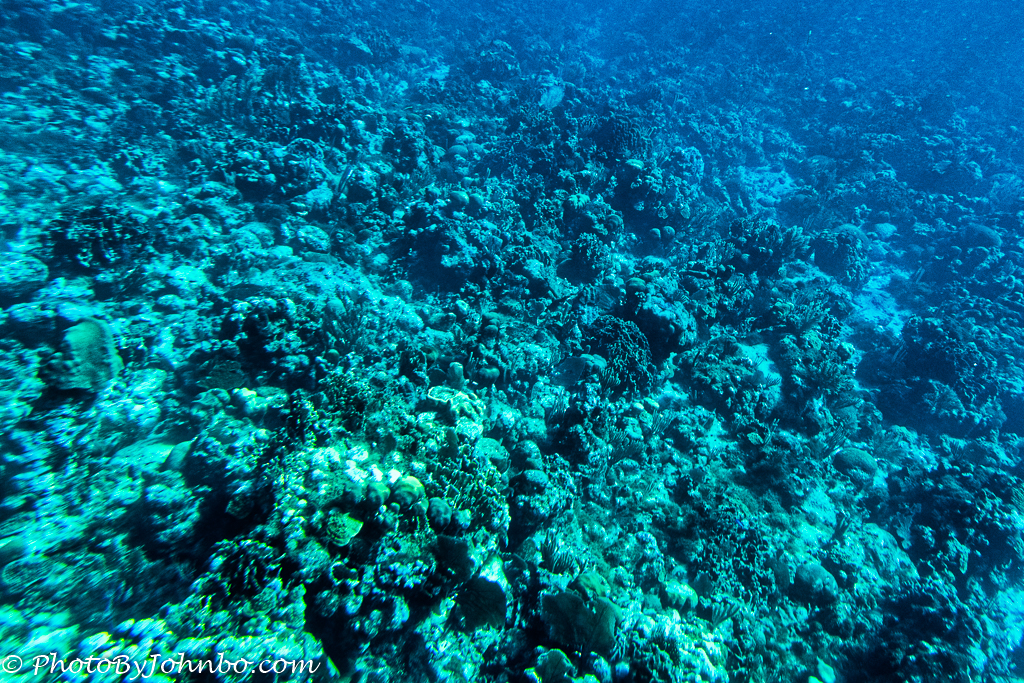The Caribbean Sea.
On a recent cruise, we visited the Mesoamerican Reef, the western hemisphere’s largest barrier reef. At almost 700 miles (1126 km) in length, it is one of the largest barrier reefs in the world. Second only to Australia’s Great Barrier Reef, it stretches from the Yucatan Peninsula in Mexico to the islands off of Honduras. At some locations, the reef is barely below the surface of the water. At Isla Roatan, we sat at the bottom of a V-hulled boat with viewing windows to observe the reef and its inhabitants. In the opening photo, the tiny bubbles near the top right of the image are an indicator of how shallow the water is offshore of this Honduran Bay island.
This close to the surface, the red and yellow end of the color spectrum is filtered from the natural sunlight leaving only blues and greens. Also known as the Great Mayan Reef, people traveling the western Caribbean can find places to visit the reef along the way. Our journey to visit the reef allowed us to view the coral structure and get a glimpse of only a few of the hundreds of species of sea life.
At Cozumel, we visited a deeper part of the reef on board the submarine Atlantis. Here the environment is completely blue. Our submarine’s depth of between 50 and 110 feet (15 to 33 m), only the blue spectrum of light is readily visible. In the image above, those iridescent blue fish are blue chromis. They are herbivores that spend their lives cleaning the algae from the reef. Other small fish that support the health of the coral in the reef are several different varieties of parrotfish. Almost every photo of the reef from the submarine featured at least one of these little blue algae eaters.
As we descended in the submarine, we saw plenty of these sergeant major damselfish. These little fish liked to swim close to the submarine as we descended. This one, for example, was only a few inches from our porthole and accompanied us for a while on our descent to the reef some 50 or so feet (15 m) below the surface.
The reef is endangered by an invasive red lionfish. Fortunately, we didn’t see any on our visits to the reef. What makes the lionfish so damaging is that it is a predator to most of the algae-eating species that tend the reef and help it survive. The reef is also home to many species of endangered sea turtles and manatees. According to an article on Wikipedia, the lionfish can remove almost all of the reef-supporting algae-eating species in only a few months ensuring the death of the coral reef in that area.
As we dove deeper into the reef, we visited a scuttled ship, the FELIPE XICOTANCATL C-53. This Mexican Navy ship was originally a United States Navy mine sweeper ship. In 1962, it was sold to the Mexican Navy, converted to a gunboat, and stationed in the Mexican Caribbean. It was scuttled and sunk purposely to provide a safe place for divers to explore while keeping them away from the fragile reef ecosystem. It now lies in about 82 feet (25 m) of water near the edge of the underwater park off Cozumel. Viewing the reef requires a wristband that indicates fees paid by the wearer to support the Cozumel Underwater Marine Park.
Prior to returning to the surface, we left the area of the reef and descended to 110 feet (33 m) below the surface where we followed the white sandy bottom of the island of Cozumel until it abruptly fell away. Each side of the sub was allowed to see the abyss that descends to a deep trench sinking to a base of about 2000 feet (600 m) below the surface. This drop-off is essentially the end of the island of Cozumel.
We journeyed to the Mesoamerican Reef from Honduras and from Cozumel, Mexico. On my Flickr Gallery here, you will find many more images from both undersea venues exploring the reef.
John Steiner








Awesome photos
Thank you. It is an awesome place to photograph.
Beautiful photos, sir. You are far braver than I!
Thank you! I admit some trepidation to the tight confines of the glass bottom boat, but felt no concern regarding the submarine. I know that people who don’t like confined spaces would have issues. Both vessels are small and crowded when full. Pics of the interiors will be included in upcoming posts.
What a wonderful adventure, John, and wonderful photographs to illustrate!
It was a great adventure, so unusual. I am happy the photos turned out. I expected they might not look so good. It did help to tweak them in post processing to help remove the haziness of the water.
Underwater photography is really tricky, but you pulled it off easily!
[…] and its treasures, and view some more undersea images of the Mesoamerican Reef, my original post is here. This post is all about the […]